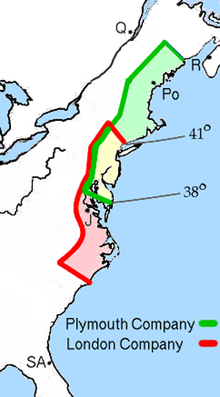Colonial America/Week 3
Early colonial failures
[edit | edit source]In 1526, Lucas Vázquez de Ayllón founded the colony San Miguel de Guadalupe in present day Georgia or South Carolina. The colony only lasted a short while before disintegrating. It was also notable for perhaps being the first instance of African slave labor within the present boundry of the United States.
Pánfilo de Narváez attempted to start a colony in Florida in 1528 . The Narváez expedition ended in disaster with only four members making it to Mexico in 1536. The Spanish Colony of Pensacola in West Florida (1559) was destroyed by hurricane in 1561.
The most notable English failures were the "Lost Colony of Roanoke" (1587-90) and the Popham Colony in Maine (1607-8).
Chesapeake Bay area
[edit | edit source]
Jamestown
[edit | edit source]The first successful English colony was Jamestown, established in 1607, on a small river near Chesapeake Bay. The venture was financed and coordinated by the London Virginia Company, a joint stock company looking for gold. Its first years were extremely difficult, with very high death rates from disease and starvation, wars with local Indiginous Americans, little gold, and a lack of food/water (the water was infected by malaria). The colony barely survived, by turning to tobacco as a cash crop. By the late 17th century Virginia's export economy was largely based on tobacco, and new, richer settlers came in to take up large portions of land, build large plantations and import indentured servants and slaves.
In 1676, Bacon's Rebellion occurred, but was suppressed by royal officials. After Bacon's Rebellion, African slaves were rapidly replacing English indentured servants as Virginia's main labor force.
The colonial assembly that had governed the colony since its establishment was dissolved but was reinstated in 1630. It shared power with a royally appointed governor. On a more local level, governmental power was invested in county courts, also not elected. As cash crop producers, Chesapeake plantations were heavily dependent on trade. With easy navigation by river, few towns and no cities developed; planters shipped directly to Britain. High death rates and a very young population profile characterized the colony during its first decades.
